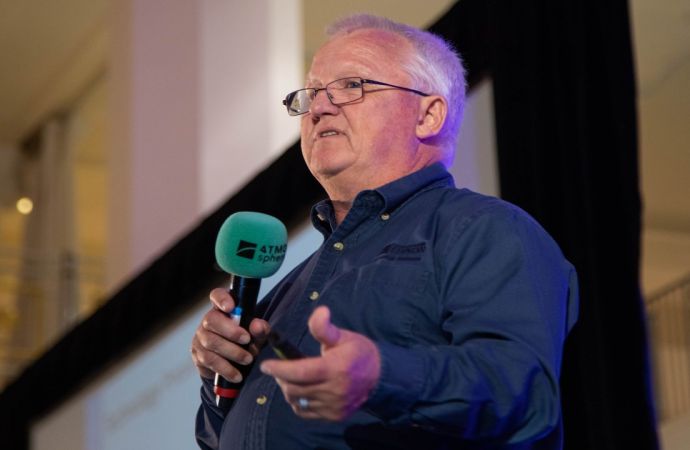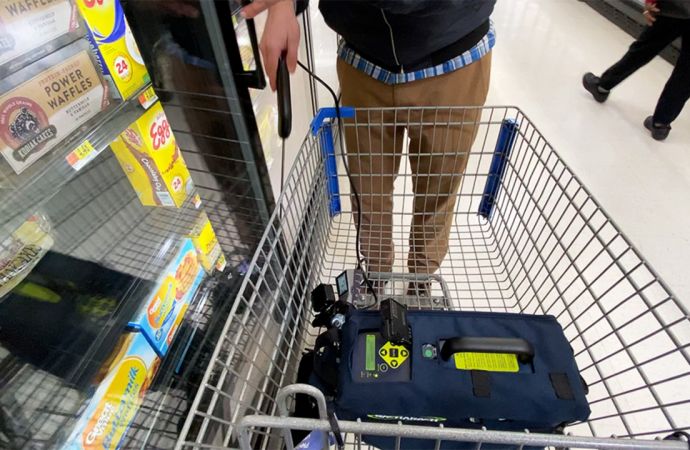In a webinar hosted by the U.S. Environmental Protection Agency on 10 November, Bella Maranion from EPA presented federal sector leadership to reduce HFC emissions through procurement. Special focus was given to the ammonia/CO2 cascade system at a Texas Air Force Base commissary.

Under the Significant New Alternatives Policy (SNAP) programme, the U.S. EPA works closely with government agencies, the military and standardisation organisations on the adoption of climate friendly refrigerant solutions. During the webinar, EPA Program Analyst Bella Maranion presented on-going actions of the federal government to procure environmentally friendly refrigerants.
Maranion raised concerns over the significant growth of HFC emissions, particularly in the refrigeration and air conditioning sectors. In 2010, federal agencies reported HFC emissions of nearly 2.2 million metric tons (MMT) CO2eq. Currently HFCs count for 1.5 per cent of all greenhouse emissions but they are expected to triple by 2030.
In response to these alarming figures, in June 2013 President Obama presented his Climate Action Plan to address HFC emissions. The plan included measures to foster federal leadership in this field by mandating that cleaner alternatives to HFCs should be acquired whenever feasible and by transitioning to equipment using safe, more sustainable alternatives over time.
$222 million each year to keep warm (and cool down) federal officials
Maranion explained that the Climate Action Plan is “a very large incentive for manufacturers as the federal government is such a big customer.”
Indeed, the U.S. federal government is one of the biggest purchasers of goods and services, including air conditioning and refrigeration technology. Maranion stated that the government owns or leases more than 635.000 vehicles and more than 353.000 buildings. It also spends nearly $191 billion each year on supplies and equipment, with $222 million allocated solely to refrigeration and air conditioning.
There were two federal actions earlier this year addressing HFCs:
Executive Order (EO) 13693 of March 2015 (“Planning for Federal Sustainability in the Next Decade”), a very broad order that aims for the federal government to reduce direct greenhouse gas emission by at least 40% by 2025. Under this executive order, agencies are required to purchase sustainable products and services identified in EPA programmes, including alternatives to ozone depleting substances and high-GWP HFCs (where feasible, as identified by SNAP).
Second, the Federal Acquisition Regulation (FAR) proposed a rule in May 2015 that addressed HFCs by directing the government to procure alternatives to high-GWP HFCs. Under this rule, where feasible, substitute acceptable alternatives (as identified by SNAP) should be sought. The final rule is currently being drafted.
Moreover, the text of EPA’s 608 Proposal to improve the sale, handling, recovery, and recycling of refrigerants was finally published on 9 November. This rule aims to strengthen existing requirements on handling refrigerants and applies them to ODS and HFC refrigerants. EPA estimates that the rule alone will reduce HFC emissions by 7 MMTCO2eq in 2025.
Maranion listed the U.S. Department of Defense (DoD), one of the oldest and largest government agencies, as an example of federal action. The DoD is currently taking different steps to ensure HFC emission reductions. Moreover, at a White House event in October, the DoD declared its commitment to reduce high-GWP HFCs and seek low-GWP alternatives. Research and development funding for low-GWP refrigerants for military application has also been provided: up to $3 million over a period of 3 years to fund competitively selected research and development projects.
Case study: ammonia/CO2 cascade system
John Stuit, who leads the design and construction team for the Defense Commissary Agency (DeCA), presented a case study on the ammonia and CO2 cascade system installed at the Lackland Air Force Base commissary. DeCA is the designated supermarket for the military with 240 grocery stores in military bases worldwide.
“Just like any other chain of supermarket stores, we are contemplating what future refrigeration systems will be,” said Stuit.
He added that they are looking for a solution that would work in hot climates with no penalty on energy consumption.
CTA Architects Engineers came up with the proposal for DeCA to go 100 per cent natural, with a cascade ammonia (NH3) and carbon dioxide (CO2) system. At that time, CO2 transcritical systems were not considered capable of meeting energy goals in hot climates, such as Texas.
Hillphoenix, piloted the system in the lab and then in the large DeCA store. The system contained only 81 pounds of ammonia in nine chiller modules sequestered on the roof of the commissary; eighteen hundred pounds of CO2 are used to chill cases via a low-temperature DX system and a medium-temperature pumped secondary system.
The National Renewable Energy Laboratory worked on the comparative energy analysis and found compressor energy savings of 8 per cent compared to an equivalent R404A system.
DeCA also has experience with natural refrigerant systems in other locations; it is also working very strongly with CO2 transcritical solutions. In fact, this is the standard design for DeCA’s European stores.
Maranion raised concerns over the significant growth of HFC emissions, particularly in the refrigeration and air conditioning sectors. In 2010, federal agencies reported HFC emissions of nearly 2.2 million metric tons (MMT) CO2eq. Currently HFCs count for 1.5 per cent of all greenhouse emissions but they are expected to triple by 2030.
In response to these alarming figures, in June 2013 President Obama presented his Climate Action Plan to address HFC emissions. The plan included measures to foster federal leadership in this field by mandating that cleaner alternatives to HFCs should be acquired whenever feasible and by transitioning to equipment using safe, more sustainable alternatives over time.
$222 million each year to keep warm (and cool down) federal officials
Maranion explained that the Climate Action Plan is “a very large incentive for manufacturers as the federal government is such a big customer.”
Indeed, the U.S. federal government is one of the biggest purchasers of goods and services, including air conditioning and refrigeration technology. Maranion stated that the government owns or leases more than 635.000 vehicles and more than 353.000 buildings. It also spends nearly $191 billion each year on supplies and equipment, with $222 million allocated solely to refrigeration and air conditioning.
There were two federal actions earlier this year addressing HFCs:
Executive Order (EO) 13693 of March 2015 (“Planning for Federal Sustainability in the Next Decade”), a very broad order that aims for the federal government to reduce direct greenhouse gas emission by at least 40% by 2025. Under this executive order, agencies are required to purchase sustainable products and services identified in EPA programmes, including alternatives to ozone depleting substances and high-GWP HFCs (where feasible, as identified by SNAP).
Second, the Federal Acquisition Regulation (FAR) proposed a rule in May 2015 that addressed HFCs by directing the government to procure alternatives to high-GWP HFCs. Under this rule, where feasible, substitute acceptable alternatives (as identified by SNAP) should be sought. The final rule is currently being drafted.
Moreover, the text of EPA’s 608 Proposal to improve the sale, handling, recovery, and recycling of refrigerants was finally published on 9 November. This rule aims to strengthen existing requirements on handling refrigerants and applies them to ODS and HFC refrigerants. EPA estimates that the rule alone will reduce HFC emissions by 7 MMTCO2eq in 2025.
Maranion listed the U.S. Department of Defense (DoD), one of the oldest and largest government agencies, as an example of federal action. The DoD is currently taking different steps to ensure HFC emission reductions. Moreover, at a White House event in October, the DoD declared its commitment to reduce high-GWP HFCs and seek low-GWP alternatives. Research and development funding for low-GWP refrigerants for military application has also been provided: up to $3 million over a period of 3 years to fund competitively selected research and development projects.
Case study: ammonia/CO2 cascade system
John Stuit, who leads the design and construction team for the Defense Commissary Agency (DeCA), presented a case study on the ammonia and CO2 cascade system installed at the Lackland Air Force Base commissary. DeCA is the designated supermarket for the military with 240 grocery stores in military bases worldwide.
“Just like any other chain of supermarket stores, we are contemplating what future refrigeration systems will be,” said Stuit.
He added that they are looking for a solution that would work in hot climates with no penalty on energy consumption.
“We wanted a future-proof system not subject to changing regulatory rules.”
CTA Architects Engineers came up with the proposal for DeCA to go 100 per cent natural, with a cascade ammonia (NH3) and carbon dioxide (CO2) system. At that time, CO2 transcritical systems were not considered capable of meeting energy goals in hot climates, such as Texas.
Hillphoenix, piloted the system in the lab and then in the large DeCA store. The system contained only 81 pounds of ammonia in nine chiller modules sequestered on the roof of the commissary; eighteen hundred pounds of CO2 are used to chill cases via a low-temperature DX system and a medium-temperature pumped secondary system.
The National Renewable Energy Laboratory worked on the comparative energy analysis and found compressor energy savings of 8 per cent compared to an equivalent R404A system.
DeCA also has experience with natural refrigerant systems in other locations; it is also working very strongly with CO2 transcritical solutions. In fact, this is the standard design for DeCA’s European stores.
“We are now bringing that technology to our stores in the United States, with our first CO2 transcritical in Newport, New London. We have a couple of stores in the Seattle area, where we want to put the systems in. And we also want to put a transcritical CO2 system in Edwards Air Force Base in southern California. So we are piloting more than ammonia and CO2 cascade systems; we are looking at all solutions that are out there and we hope to find a solution that will work best for us. This may end up that in climate A we will use one system, and in climate B another system”.
MORE INFORMATION
Related stories



